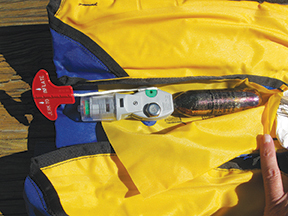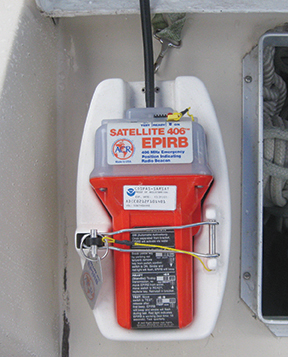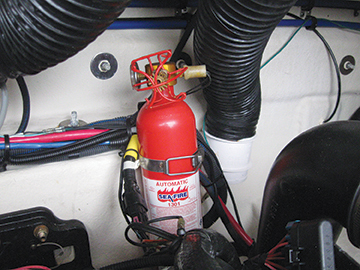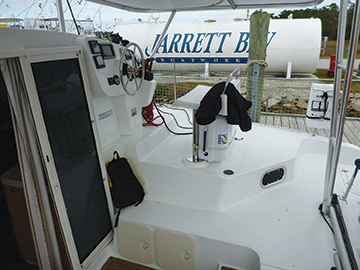Commissioning for the upcoming season is the perfect time to inspect your boat’s safety equipment (published April 2014)
As springtime rolls around and we start to get our boats ready for the upcoming season, we turn our attention to doing the usual chores; bottom paint, varnish, engine maintenance and all the other little tasks that need our attention. There is, however, one critical area most boat owners overlook and never give a second thought to. That is of checking and servicing their safety gear.
I know there is a lot to do when commissioning your boat, but this is one area you could well regret not paying more attention to should an emergency arise. None of us like to think anything will go wrong on our boats and all this extra safety stuff we carry will never be needed. With luck you will be right and you will never need to use any of the safety gear aboard, but the truth of the matter is, things do go wrong and you want to be ready just in case.
As a marine surveyor part of my job is to inspect a vessel’s safety gear. Over the years I have been surprised at just how often I find this critical equipment lacking. And I am not just talking about out of date flares and burned out running lights, but critical equipment such as life jackets and life rafts. Most owners seem a bit surprised when I point out problems with their safety gear because it is not something they give much thought to. Others tend to dismiss the importance of proper maintenance, thinking it is just another expense for something they will never use. This may be true but you do not want to wait until that critical piece of safety gear is needed, only to find out the batteries are dead or a buckle will not close. Others forget just how long it has been since they last had their equipment checked. Time tends to slip by and it is easy to lose track of inspection dates. This is why I recommend annual inspections.
Regular inspections of most safety equipment are not required on pleasure boats. I always recommend that every boat owner should do their own inspections at least once a year. With the coming of “Safe Boating Week”, May 17 thru May 23, this may be a good time to plan on doing a self-inspection on your own boat. It is also the start of most people’s sailing season, making it a good time to ensure all your gear is in order.
INSPECTING PFDs

I always suggest starting with wearable PFDs. Few owners ever take the time to inspect or even look at their PFDs. I am often surprised at just what I find when checking this important gear. The first consideration should be to make sure you could get at your PFDs when needed. I find many life vests buried deep in lockers where it would be difficult or impossible to get them in a real emergency. If you use storage bags make sure the zippers work. About half the boats I inspect with these bags I find the zippers are frozen shut making it impossible to remove the vests. It is better to use storage bags with Velcro closures.
Next, inspect each vest for any tears or other damage. Check all the straps and clasps as well. If you find any damage just replace the unit. If your life vests are more than 15 to 20 years old you should consider replacing them even if they appear to be in good condition. If you have inflatable PFDs check them as well. Manually inflate them to check for leaks and make sure the firing mechanism is showing green and does not have any corrosion. Check any lights or other equipment attached to your PFDs as well. A light is no good if the battery is dead and most I check are.
MOB DEVICES

It is important to check the throwable PFDs or man overboard devices as well. Man overboard or throwable PFDs come in all shapes and sizes from a simple seat cushion to self-inflating devices with poles and lights.

Check all straps and lines attached to these devices. More often than not I find the lines have UV damage and would likely not hold up if put under any load. For self-inflating devices or devices with lights, check as recommended with wearable PFDs. For more sophisticated devices like Switlik’s MOM, the unit should be professionally inspected and certified on a regular basis just like a life raft. As with all safety devices make sure man overboard devices are stowed so that they can be deployed quickly when needed. I have seen some devices so tightly lashed to the aft rail it would take several minutes to get free, by that time a person could be well out of sight. Finally, check any MOB lights to make sure they have fresh batteries and are fully operational.
LIFE RAFTS
If your vessel has a life raft, a quick visual inspection is a good idea. Life rafts are required to be certified by an authorized service center annually on commercial vessels. No such rule exists for private vessels but the general rule of thumb is to have them recertified every three years. The last certification date should be marked on your raft. Check this and make sure it is no more than three years old. I have seen 30-year-old rafts that had never been re-certified. The owners insisted they were still “new” because they had never been used. If your raft is located on deck make sure it is properly secured with a hydrostatic release and that the tether is attached to the vessel with the hydrostatic release as well. Lashing the raft with lines or cables is not considered safe and could make the raft difficult to deploy in an emergency. For rafts stowed below decks, make sure you can get the raft to the rail in less than 15 seconds. Check for damage to the raft and its case, if any damage is found, the raft should be professionally recertified.
EPIRBs, PLBs and YOUR DITCH BAG
 If you have EPIRBs or PLBs aboard check that they are in good condition and that the batteries have not expired. EPIRB batteries need to be replaced every five years and the expiration date will be marked on the housing. Five years can pass quickly and many forget to check regularly. Although the unit may self test ok, indicating the batteries are good, older batteries will not keep your unit activated for as long as fresh batteries. It is also very important to verify your NOAA registration is up to date and that all the contact information is correct, you can check this online. It is required to be renewed every two years.
If you have EPIRBs or PLBs aboard check that they are in good condition and that the batteries have not expired. EPIRB batteries need to be replaced every five years and the expiration date will be marked on the housing. Five years can pass quickly and many forget to check regularly. Although the unit may self test ok, indicating the batteries are good, older batteries will not keep your unit activated for as long as fresh batteries. It is also very important to verify your NOAA registration is up to date and that all the contact information is correct, you can check this online. It is required to be renewed every two years.
If you have a ditch bag it should be checked as well. Replace batteries in any flashlights as well as other electronic equipment such as portable VHFs and GPS units. Replace spare batteries as well and mark the date on them. Check any supplies with expiration dates like flares, food, water and medicines.
FIRE EXTINGUISHERS
 Fire extinguishers need to be checked annually as well. Handheld units should be checked for age and to verify the gauge is still in the green. Any unit more than 8 to10 years old should be replaced as units older than that may not function properly. Make sure all units are properly mounted and in a location easily sighted. When checking dry chemical extinguishers it is a good idea to turn the unit over and gently tap it with a rubber mallet to loosen the powder inside. If you have an automatic system in the engine compartment it should be professionally inspected every three years. If the unit is small it can be removed and taken to an authorized service center for inspection. Do not forget to run a self test on any smoke alarms and CO monitors while you are at it. Replace any alarm batteries at least once a year.
Fire extinguishers need to be checked annually as well. Handheld units should be checked for age and to verify the gauge is still in the green. Any unit more than 8 to10 years old should be replaced as units older than that may not function properly. Make sure all units are properly mounted and in a location easily sighted. When checking dry chemical extinguishers it is a good idea to turn the unit over and gently tap it with a rubber mallet to loosen the powder inside. If you have an automatic system in the engine compartment it should be professionally inspected every three years. If the unit is small it can be removed and taken to an authorized service center for inspection. Do not forget to run a self test on any smoke alarms and CO monitors while you are at it. Replace any alarm batteries at least once a year.
FLARES, LIGHTS, HORNS AND FIRST AID
Flares and visual distress signals are another item that is often buried deep in a locker where they cannot be retrieved quickly. Flares have a life span of three years and the USCG requires they be replaced once the expiration date is past. For most boaters those three years go by fast, so an annual check is a good idea. I do recommend keeping the old flares but suggest placing them in a container labeled “Old Flares.” This will help avoid confusion in an emergency.
While we are at it, it is a good idea to check your boat’s navigational and safety lights. I would say half the boats I survey have at least one navigation light out. Check that you have a working horn as well and that it can be operated from, or is stowed near, the helm. If you have a high water alarm system check that each float switch is working. Check your first aid kit. I find many of these are very old. Although some supplies in the kit may last years, others may not. Replace any items that have an expiration date.
EDUCATE YOUR CREW

As you are inspecting and then re-stowing all your safety gear, print a layout of your boat and make a schematic of all the safety gear aboard and post it somewhere visible for crewmembers to see. By doing this you can easily educate new crewmembers about your boat’s safety equipment as they come aboard and anyone can reference it when certain items are needed. Seacocks and through hulls should also be added to this diagram so your crew is aware of their placement when checking for leaks.
For most boaters this annual check should only take an afternoon or so of your time. It might make a nice break from all that sanding and painting that needs to be done. Knowing that you will start your sailing season off with all your safety gear in order will be one less thing to worry about as you untie from the dock. Hopefully you will never need to use any of this equipment but should an emergency arise it is nice to know you can count on your equipment.
Capt. Wayne Canning lives on his Irwin 40 VAYU, in Wilmington, North Carolina. A marine professional for more than 40 years, he is now a full time marine surveyor, freelance writer, and consultant/project manager. Capt. Wayne also runs web sites for those restoring project boats. Visit www.4ABetterBoat.com and www.projectboatzen.com for more information.

















